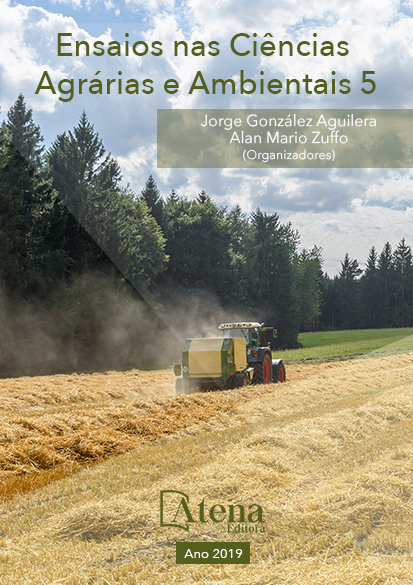
RELAÇÃO DOS RESERVATÓRIOS E CAPACIDADE DE SUPORTE EM ÁREA IRRIGÁVEL NUMA FAZENDA EM QUIXERAMOBIM-CE
A sazonalidade climática da Região
Semiárida dificulta a produção animal e vegetal
em varias situações vivenciadas pelos produtores
rurais. Portanto, objetivou-se quantificar a
disponibilidade de água para irrigação, e
determinar sua capacidade de suporte em
uma área irrigável, com simulações em quatro
reservatórios localizados em uma fazenda no
interior de Quixeramobim, no Sertão Central do
Ceará, com o auxilio da modelagem hidrológica.
O trabalho foi realizado em uma fazenda,
localizada no município de Quixeramobim–
CE. Foram realizadas simulações de quatro
reservatórios, com a utilização de um software
desenvolvido pelo pesquisador Araujo (2004),
para a modelagem. O programa chama-se
Vyelas (versão 3), que determina o volume,
por ano, de perca por elasticidade. O mesmo
foi utilizado para a simulação de estimativas
dos reservatórios, sendo feita simulação de
evaporação e rendimento no período seco
em uma analise estocástica. A relação dos
reservatórios, com sua disponibilidade de água
para irrigação e capacidade de suporte, em área
irrigável, utilizando-se a metade do volume de
entrada de cada açude apresentam uma área
irrigável total de 9,71 ha utilizando o volume
dos quatro reservatórios. Com uma produção
de biomassa de forragem total de 460.823,92
kg de MSFT/ano, e com uma capacidade de
suporte total de 92 UA. Entretanto, se forem
usados separadamente, apenas o reservatório
açude 04 apresenta uma boa produção de
forragem, mesmo sendo utilizado metade do seu volume de entrada. O açude 04 é o
que apresenta o maior potencial para produção de forragem e capacidade de suporte.
RELAÇÃO DOS RESERVATÓRIOS E CAPACIDADE DE SUPORTE EM ÁREA IRRIGÁVEL NUMA FAZENDA EM QUIXERAMOBIM-CE
-
DOI: 10.22533/at.ed.41419160118
-
Palavras-chave: disponibilidade de água, modelagem, modelos hidrológicos.
-
Keywords: water availability, modeling, hydrological models.
-
Abstract:
The climatic seasonality of the semi-arid region makes it difficult for
animal and vegetable production in several situations experienced by rural producers.
The objective of this study was to quantify the availability of water for irrigation and to
determine its support capacity in an irrigable area, with simulations in four reservoirs
located on a farm in the interior of Quixeramobim, in the Central Sertão of Ceará,
with the aid of hydrological modeling . The work was carried out in a farm, located in
the municipality of Quixeramobim-CE. Simulations of four reservoirs were carried out,
using a software developed by the researcher Araujo (2004), for the modeling. The
program is called Vyelas (version 3), which determines the volume per year of loss per
elasticity. The same was used for the simulation of reservoir estimates, and simulation
of evaporation and dry season yield in a stochastic analysis. The ratio of the reservoirs,
with their availability of water for irrigation and support capacity, in an irrigable area,
using half of the input volume of each dam present a total irrigable area of 9.71 ha
using the volume of the four reservoirs. With a total forage biomass production of
460,823.92 kg of MSFT / year, and with a total carrying capacity of 92 AU. However,
if used separately, only the reservoir canopy 04 has a good forage production, even
though half of its input volume is used. Weir 04 is the one with the greatest potential for
forage production and support capacity.
-
Número de páginas: 15
- Francisca Luiza Simão de Souza
- FRANCISCA LUIZA SIMÃO DE SOUZA


